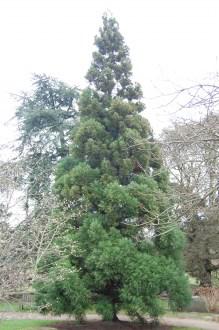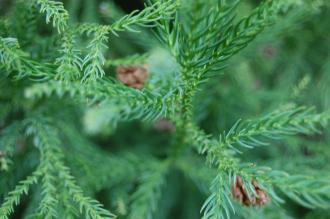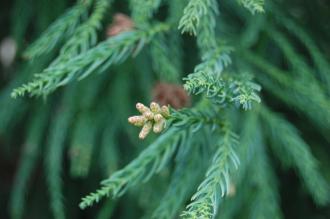
Cryptomeria japonica (18/02/2012, Kew, London)
Position: Full Sun to light shade
Flowering period: Spring
Soil: Moist, well drained
Eventual Height: 60m
Eventual Spread: 12m
Hardiness: 6a – 9b
Family: Cupressaceae
Cryptomeria japonica is a large, long lived, conical, evergreen tree. Its mature dark green leaves are slightly curving, arranged spirally around the leaf shoots, they are needle like and are up to 1cm in length. This tree produces juvenile and mature foliage, the juvenile being finer than that of the mature. The branches of the tree are horizontally spreading and are composed of many branchlets, giving the tree its dense foliage. The trunk of the tree may achieve a diameter of 4m. The bark of the tree is red brown in color and peels in vertical strips. The flowers of the tree are monoecious. The female seed cones of the plant are globular, up to 2cm in diameter with about 20-40 scales.

Cryptomeria japonica leaf with female cones in background (18/02/2012, Kew, London)
Cryptomeria japonica, commonly known as Japanese Cedar, Japanese Red Cedar or Sugi (in Japan), is native to Japan. The tree is often called the Japanese Cedar but is not related to the Cedar tree in any way. It was introduced into the UK in 1861. Cryptomeria japonica is the only species found in this genus. It is the national tree of Japan.
The etymological root of the binomial name Cryptomeria is derived from the Greek name kryptos ’hidden’ and meros ’part’, in reference to the inconspicuous male cones. Japonica is derived from the Latin meaning of Japan.

Cryptomeria japonica bark (18/02/2012, Kew, London)
The landscape architect may find Cryptomeria japonica useful as an attractive evergreen specimen tree whare space permits. Care should be taken when locating this tree as its pollen causes hay fever. This tree may be coppiced.
Ecologically, C. japonica is attractive to larvae of some moths as it provides them with a source of food.
The Royal Horticultural Society has given C. japonica their prestigious Award of Garden Merit in 1993.

Cryptomeria japonica immature male cones (18/02/2012, Kew, London)
C. japonica prefers moist, deep, well-drained soils. It tolerates most pH of soil. It will not tolerate poor soils.
C. japonica requires little maintenance.
Advertisement
